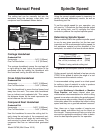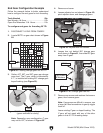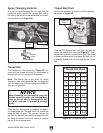
Model G0765 (Mfd. Since 12/13)
-47-
Thread Dial
The numbers on the thread dial (Figure 65) are
used with the thread dial chart to show when to
engage the half nut during inch threading.
Note: The thread dial is not used for metric
threading. You must leave the half nut engaged
from the beginning until the turning is complete for
this type of operation.
When threading, we recommend using the
slowest speed possible and avoiding deep
cuts, so you are able to disengage the half
nut when required to prevent a carriage
crash!
When the first cutting pass is complete, the opera-
tor disengages the carriage from the leadscrew
using the half nut lever. The operator returns the
carriage for the next pass and re-engages the half
nut using the same thread dial setting to resume
the cut in the previous pass.
Apron Threading Controls
The half nut lever engages the carriage with the
leadscrew, which moves the carriage and cutting
tool along the length of the workpiece for thread-
ing operations (see Figure 65).
Figure 65. Apron threading controls.
Engaged
Halfnut
Lever
Disengaged
Half Nut
Lever
Thread Dial
Thread Dial Chart
The thread dial chart is located on the headstock,
as shown in Figure 66.
TPI Scale TPI Scale
Thread Dial Chart
12
13
14
16
18
19
20
22
24
1,3,5,7
1
1,5
1 – 8
1,5
1
1,3,5,7
1,5
1 – 8
26
28
32
36
38
40
44
48
52
1,5
1,3,5,7
1 – 8
1,3,5,7
1,5
1 – 8
1,3,5,7
1 – 8
1,3,5,7
TPI Gear Setup TPI Gear Setup
12
13
14
16
18
19
20
22
24
A B C D A B C D
40 30 26 40 60 65
40 30
35
40
45
57
50
55
60 60
40
40
40
40
40
40
40
50
65 65
65 65
65 65
65
65
65 65
65 65
65
65
60
60
28
32
36
38
40
44
48
52
20
20
20
20
20
20
20
20
50 60
35
40
45
57
50
55
60
65
Figure 67. Thread dial chart.
Figure 66. Thread dial chart location.
Find the TPI (threads per inch) that you want to
cut on the thread dial chart (see Figure 67), then
reference the scale number to the right. The scale
numbers indicate when to engage the half nut for
a specific thread pitch as indicated by the thread
dial.
Thread Dial
Chart


















